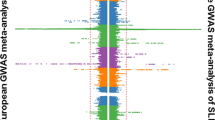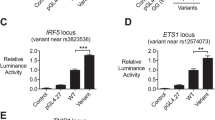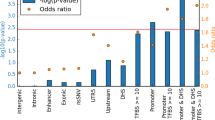Abstract
Systemic lupus erythematosus (SLE) is a prototypic autoimmune disorder with a complex pathogenesis in which genetic, hormonal and environmental factors have a role. Rare mutations in the TREX1 gene, the major mammalian 3′–5′ exonuclease, have been reported in sporadic SLE cases. Some of these mutations have also been identified in a rare pediatric neurological condition featuring an inflammatory encephalopathy known as Aicardi–Goutières syndrome (AGS). We sought to investigate the frequency of these mutations in a large multi-ancestral cohort of SLE cases and controls. A total of 40 single-nucleotide polymorphisms (SNPs), including both common and rare variants, across the TREX1 gene, were evaluated in ∼8370 patients with SLE and ∼7490 control subjects. Stringent quality control procedures were applied, and principal components and admixture proportions were calculated to identify outliers for removal from analysis. Population-based case–control association analyses were performed. P-values, false-discovery rate q values, and odds ratios (OR) with 95% confidence intervals (CI) were calculated. The estimated frequency of TREX1 mutations in our lupus cohort was 0.5%. Five heterozygous mutations were detected at the Y305C polymorphism in European lupus cases but none were observed in European controls. Five African cases incurred heterozygous mutations at the E266G polymorphism and, again, none were observed in the African controls. A rare homozygous R114H mutation was identified in one Asian SLE patient, whereas all genotypes at this mutation in previous reports for SLE were heterozygous. Analysis of common TREX1 SNPs (minor allele frequency (MAF)>10%) revealed a relatively common risk haplotype in European SLE patients with neurological manifestations, especially seizures, with a frequency of 58% in lupus cases compared with 45% in normal controls (P=0.0008, OR=1.73, 95% CI=1.25–2.39). Finally, the presence or absence of specific autoantibodies in certain populations produced significant genetic associations. For example, a strong association with anti-nRNP was observed in the European cohort at a coding synonymous variant rs56203834 (P=2.99E−13, OR=5.2, 95% CI=3.18–8.56). Our data confirm and expand previous reports and provide additional support for the involvement of TREX1 in lupus pathogenesis.
This is a preview of subscription content, access via your institution
Access options
Subscribe to this journal
Receive 6 digital issues and online access to articles
$119.00 per year
only $19.83 per issue
Buy this article
- Purchase on Springer Link
- Instant access to full article PDF
Prices may be subject to local taxes which are calculated during checkout


Similar content being viewed by others
References
Stetson DB, Medzhitov R . Antiviral defense: interferons and beyond. J Exp Med 2006; 203: 1837–1841.
Crow MK . Type I interferon in systemic lupus erythematosus. Curr Top Microbiol Immunol 2007; 316: 359–386.
Ronnblom L, Pascual V . The innate immune system in SLE: type I interferons and dendritic cells. Lupus 2008; 17: 394–399.
Dussaix E, Lebon P, Ponsot G, Huault G, Tardieu M . Intrathecal synthesis of different alpha-interferons in patients with various neurological diseases. Acta Neurol Scand 1985; 71: 504–509.
Richards A, van den Maagdenberg AM, Jen JC, Kavanagh D, Bertram P, Spitzer D et al. C-terminal truncations in human 3′-5′ DNA exonuclease TREX1 cause autosomal dominant retinal vasculopathy with cerebral leukodystrophy. Nat Genet 2007; 39: 1068–1070.
Rice G, Newman WG, Dean J, Patrick T, Parmar R, Flintoff K et al. Heterozygous mutations in TREX1 cause familial chilblain lupus and dominant Aicardi–Goutieres syndrome. Am J Hum Genet 2007; 80: 811–815.
Lee-Kirsch MA, Gong M, Chowdhury D, Senenko L, Engel K, Lee YA et al. Mutations in the gene encoding the 3′-5′ DNA exonuclease TREX1 are associated with systemic lupus erythematosus. Nat Genet 2007; 39: 1065–1067.
De Laet C, Goyens P, Christophe C, Ferster A, Mascart F, Dan B . Phenotypic overlap between infantile systemic lupus erythematosus and Aicardi–Goutières syndrome. Neuropediatrics 2005; 36: 399–402.
Mazur DJ, Perrino FW . Structure and expression of the TREX1 and TREX2 3′-5′ exonuclease genes. J Biol Chem 2001; 276: 14718–14727.
Morita M, Stamp G, Robins P, Dulic A, Rosewell I, Hrivnak G et al. Gene-targeted mice lacking the TREX1 (DNase III) 3′-->5′ DNA exonuclease develop inflammatory myocarditis. Mol Cell Biol 2004; 24: 6719–6727.
Stetson DB, Ko JS, Heidmann T, Medzhitov R . TREX1 prevents cell-intrinsic initiation of autoimmunity. Cell 2008; 134: 587–598.
Yang YG, Lindahl T, Barnes DE . Trex1 exonuclease degrades ssDNA to prevent chronic checkpoint activation and autoimmune disease. Cell 2007; 131: 873–886.
Kavanagh D, Spitzer D, Kothari PH, Shaikh A, Liszewski MK, Richards A et al. New roles for the major human 3′–5′ exonuclease TREX1 in human disease. Cell Cycle 2008; 7: 1718–1725.
Rice G, Patrick T, Parmar R, Taylor CF, Aeby A, Aicardi J et al. Clinical and molecular phenotype of Aicardi-Goutieres syndrome. Am J Hum Genet 2007; 81: 713–725.
De Silva U, Choudhury S, Bailey SL, Harvey S, Perrino FW, Hollis T . The crystal structure of TREX1 explains the 3′ nucleotide specificity and reveals a polyproline II helix for protein partnering. J Biol Chem 2007; 282: 10537–10543.
Lehtinen DA, Harvey S, Mulcahy MJ, Hollis T, Perrino FW . The TREX1 double-stranded DNA degradation activity is defective in dominant mutations associated with autoimmune disease. J Biol Chem 2008; 283: 31649–31656.
Crow YJ, Hayward BE, Parmar R, Robins P, Leitch A, Ali M et al. Mutations in the gene encoding the 3′-5′ DNA exonuclease TREX1 cause Aicardi–Goutières syndrome at the AGS1 locus. Nat Genet 2006; 38: 917–920.
Raymond AA, Zariah AA, Samad SA, Chin CN, Kong NC . Brain calcification in patients with cerebral lupus. Lupus 1996; 5: 123–128.
Appenzeller S, Vasconcelos FA, Li LM, Costallat LT, Cendes F . Quantitative magnetic resonance imaging analyses and clinical significance of hyperintense white matter lesions in systemic lupus erythematosus patients. Ann Neurol 2008; 64: 635–643.
Sibbitt WL, Brooks WM, Kornfeld M, Hart BL, Bankhurst AD, Roldan CA . Magnetic resonance imaging and brain histopathology in neuropsychiatric systemic lupus erythematosus. Semin Arthritis Rheum 2010; 40: 32–52.
Ramantani G, Kohlhase J, Hertzberg C, Innes AM, Engel K, Hunger S et al. Expanding the phenotypic spectrum of lupus erythematosus in Aicardi-Goutières syndrome. Arthritis Rheum 2010; 62: 1469–1477.
De Vries B, Steup-Beekman GM, Haan J, Bollen EL, Luyendijk J, Frants RR et al. TREX1 gene variant in neuropsychiatric systemic lupus erythematosus. Ann Rheum Dis 2010; 69: 1886–1887.
Venere M, Snyder A, Zgheib O, Halazonetis TD . Phosphorylation of ATR-interacting protein on Ser239 mediates an interaction with breast-ovarian cancer susceptibility 1 and checkpoint function. Cancer Res 2007; 67: 6100–6105.
Hur JW, Sung YK, Shin HD, Park BL, Cheong HS, Bae SC . TREX1 polymorphisms associated with autoantibodies in patients with systemic lupus erythematosus. Rheumatol Int 2008; 28: 783–789.
Mikdashi J, Handwerger B . Predictors of neuropsychiatric damage in systemic lupus erythematosus: data from the Maryland lupus cohort. Rheumatology (Oxford) 2004; 43: 1555–1560.
Kaufman KM, Kelly JA, Herring BJ, Adler AJ, Glenn SB, Namjou B et al. Evaluation of the genetic association of the PTPN22 R620W polymorphism in familial and sporadic systemic lupus erythematosus. Arthritis Rheum 2006; 54: 2533–2540.
International Consortium for Systemic Lupus Erythematosus Genetics (SLEGEN) Harley JB, Alarcón-Riquelme ME, Criswell LA, Jacob CO, Kimberly RP et al. Genome-wide association scan in women with systemic lupus erythematosus identifies susceptibility variants in ITGAM, PXK, KIAA1542 and other loci. Nat Genet 2008; 40: 204–210.
Jacob CO, Reiff A, Armstrong DL, Myones BL, Silverman E, Klein-Gitelman M et al. Identification of novel susceptibility genes in childhood-onset systemic lupus erythematosus using a uniquely designed candidate gene pathway platform. Arthritis Rheum 2007; 56: 4164–4173.
Cooper GS, Parks CG, Treadwell EL, St Clair EW, Gilkeson GS, Cohen PL et al. Differences by race, sex and age in the clinical and immunologic features of recently diagnosed systemic lupus erythematosus patients in the southeastern United States. Lupus 2002; 3: 161–167.
Alarcón GS, McGwin Jr G, Petri M, Ramsey-Goldman R, Fessler BJ, Vilá LM et al. Time to renal disease and end-stage renal disease in PROFILE: a multiethnic lupus cohort. PLoS Med 2006; 3: e396.
Hochberg MC . Updating the American College of Rheumatology revised criteria for the classification of systemic lupus erythematosus. Arthritis Rheum 1997; 40: 1725.
Purcell S, Neale B, Todd-Brown K, Thomas L, Ferreira MAR, Bender D et al. PLINK: a toolset for whole-genome association and population-based linkage analysis. Am J Hum Genet 2007; 81: 559–575.
Barrett JC, Fry B, Maller J, Daly MJ . Haploview: analysis and visualization of LD and haplotype maps. Bioinformatics 2005; 21: 263–265.
Purcell S, Daly MJ, Sham PC . WHAP: haplotype-based association analysis. Bioinformatics 2007; 23: 255–256.
Price AL, Patterson NJ, Plenge RM, Weinblatt ME, Shadick NA, Reich D . Principal components analysis corrects for stratification in genome-wide association studies. Nat Genet 2006; 38: 904–909.
Acknowledgements
The cooperation of patients and normal control individuals involved in this study as well as physicians that provide samples is gratefully acknowledged. At the Oklahoma Medical Research Foundation, the work was supported by the NIH (AR042460, RR015577, AR048940, RR020143, AI24717, AR62277), Lupus Foundation of America, the Alliance for Lupus Research, the US Department of Veterans Affairs. At the Washington University School of Medicine (St Louis, MO, USA), the work was supported by grants (HL083822 (PHK), and NS062069 (JPA)), and the Cerebral Retinal Vasculopathy Fund. At the University of Alabama at Birmingham, the work was supported by grants AR33062 (RPK), AR49084 (RPK) and 5UL1RR02777. At the Johns Hopkins University School of Medicine, the work was supported by The Hopkins Lupus Cohort (NIH AR43727) and UL1RR025005 from the National Center for Research Resources (NCRR). At the University of Colorado, Denver School of Medicine, the work was supported by a NIH grant R21AI070304. At the Medical University of South Carolina, Charleston, USA, the project was supported by award number UL1RR029882 from the National Center for Research Resources. (The content is solely the responsibility of the authors and does not necessarily represent the official views of the National Center for Research Resources or the National Institutes of Health). At the Rosalind Russell Medical Research Center for Arthritis, University of California, San Francisco, USA, the work was supported by Kirkland Scholar Award, US Public Health Service National Center for Research Resources, M01 RR-00079 and NIH grants AR044804, AR02175 and AR052300. At the Northwestern University, Feinberg School of Medicine, Chicago, IL, USA, the work was supported by NIH grants K24 AR 002138, P60 2 AR30692, PO1 AR49084 and UL1RR025741. At the Wake Forest University Health Sciences, Department of Biochemistry, the work was supported by R01GM069962 and Alliance for Lupus Research (67692) awards. We acknowledge grants from the European Science Foundation for the BIOLUPUS network, the Swedish Research Council, Swedish Association against Rheumatism, the Swedish International Development Agency (SIDA) and Gustaf Vth–80th jubilee Foundation to MEAR and the NIH grant CA141700-01. For GENLES: Argentina: Hugo R Scherbarth, MD; Pilar C Marino, MD; Estela L Motta, MD at Servicio de Reumatología, Hospital Interzonal General de Agudos ‘Dr Oscar Alende’, Mar del Plata, Argentina. Susana Gamron, MD; Cristina Drenkard, MD; Emilia Menso, MD at Servicio de Reumatología de la UHMI 1, Hospital Nacional de Clínicas, Universidad Nacional de Córdoba, Córdoba, Argentina. Alberto Allievi, MD; Guillermo A Tate, MD at Organización Médica de Investigación, Buenos Aires, Argentina. Jose L Presas, MD at Hospital General de Agudos Dr Juán A Fernandez, Buenos Aires, Argentina. Simon A Palatnik, MD; Marcelo Abdala, MD; Mariela Bearzotti, PhD at Facultad de Ciencias Medicas, Universidad Nacional de Rosario y Hospital Provincial del Centenario, Rosario, Argentina. Alejandro Alvarellos, MD; Francisco Caeiro, MD; Ana Bertoli, MD at Servicio de Reumatología, Hospital Privado, Centro Medico de Córdoba, Córdoba, Argentina. Sergio Paira, MD; Susana Roverano, MD at Hospital José M. Cullen, Santa Fe, Argentina. Cesar E Graf, MD; Estela Bertero, PhD at Hospital San Martín, Paraná. Cesar Caprarulo, MD; Griselda Buchanan, PhD at Hospital Felipe Heras, Concordia, Entre Ríos, Argentina. Carolina Guillerón, MD; Sebastian Grimaudo, PhD; Jorge Manni, MD at Departamento de Inmunología, Instituto de Investigaciones Médicas ‘Alfredo Lanari’, Buenos Aires, Argentina. Luis J Catoggio, MD; Enrique R Soriano, MD; Carlos D Santos, MD at Sección Reumatología, Servicio de Clínica Medica, Hospital Italiano de Buenos Aires y Fundación Dr Pedro M Catoggio para el Progreso de la Reumatología, Buenos Aires, Argentina. Cristina Prigione, MD; Fernando A Ramos, MD; Sandra M Navarro, MD at Servicio de Reumatología, Hospital Provincial de Rosario, Rosario, Argentina. Guillermo A Berbotto, MD; Marisa Jorfen, MD; Elisa J Romero, PhD at Servicio de Reumatología Hospital Escuela Eva Perón. Granadero Baigorria, Rosario, Argentina. Mercedes A Garcia, MD; Juan C Marcos MD; Ana I Marcos, MD at Servicio de Reumatología, Hospital Interzonal General de Agudos General San Martín, La Plata. Carlos E Perandones, MD; Alicia Eimon, MD at Centro de Educación Médica e Investigaciones Clínicas (CEMIC), Buenos Aires, Argentina. Cristina G Battagliotti, MD at Hospital de Niños Dr Orlando Alassia, Santa Fe, Argentina. Perú is represented by: Dr Eduardo Acevedo and Dr Mariano Cucho, Hospital Nacional Guillermo Almenara Irigoyen, Lima, Perú. Mexico is represented by Dr Ignacio García de la Torre, Hospital General de Occidente, Zapopan, Jalisco; Dr Mario Cardiel Ríos, Hospital General Dr Miguel Silva, Morelia, Michoacán; Dr José Francisco Moctezuma, Hospital General de México, México, DF; Dr Marco Maradiaga Ceceña, Hospital General de Culiacán, Culiacán, Sinaloa. The members of the BIOLUPUS network are: Sandra D’Alfonso, Department of Medical Sciences and IRCAD, University of Eastern Piedmont, Novara, Italy; Bernard R. Lauwerys, Cliniques Universitaires Saint-Luc, Université catholique de Louvain, Bruxells, Belgium; Emoke Endreffy, Department of Pediatrics and Health Center, University of Szeged, Szeged, Hungary; László Kovács, Department of Rheumatology, Albert Szent-Györgyi Clinical Centre, University of Szeged, Szeged, Hungary; Carlos Vasconcelos, Hospital Santo Antonio and ICBAS, Porto, Portugal; Berta Martins da Silva, UMIB/ICBAS, Immunogenetics laboratory, Universidado do Porto, Porto, Portugal; Iñigo Rúa Figueroa, Hospital Doctor Negrin, Las Palmas de Gran Canaria, Spain. Sandra D’Alfonso, Nadia Barizzone (Department of Medical Sciences and IRCAD, University of Eastern Piedmont, Novara, Italy); Gian Domenico Sebastiani (Azienda Ospedaliera San Camillo-Forlanini, Roma, Italy); Mauro Galeazzi, (Siena University, Siena, Italy) Maria Giovanna Danieli (Clinica Medica di Scienze Mediche e Chirurgiche, Universitá Politecnica delle Marche, Ancona, Italy); Giovanni La Montagna (Rheumatology Unit Second University of Naples, Naples, Italy) and Maria Grazia Sabbadini (Vita-Salute San Raffaele University of Milan, Italy).
Author information
Authors and Affiliations
Corresponding author
Ethics declarations
Competing interests
The authors declare no conflict of interest.
Rights and permissions
About this article
Cite this article
Namjou, B., Kothari, P., Kelly, J. et al. Evaluation of the TREX1 gene in a large multi-ancestral lupus cohort. Genes Immun 12, 270–279 (2011). https://doi.org/10.1038/gene.2010.73
Received:
Revised:
Accepted:
Published:
Issue Date:
DOI: https://doi.org/10.1038/gene.2010.73
Keywords
This article is cited by
-
Disulfiram ameliorates STING/MITA-dependent inflammation and autoimmunity by targeting RNF115
Cellular & Molecular Immunology (2024)
-
Characteristics and genetic analysis of patients suspected with early-onset systemic lupus erythematosus
Pediatric Rheumatology (2022)
-
Autoinflammation – Unterschiede bei Kindern und Erwachsenen
rheuma plus (2022)
-
Autoinflammation – Unterschiede bei Kindern und Erwachsenen
Zeitschrift für Rheumatologie (2022)
-
The cGAS–STING pathway as a therapeutic target in inflammatory diseases
Nature Reviews Immunology (2021)



